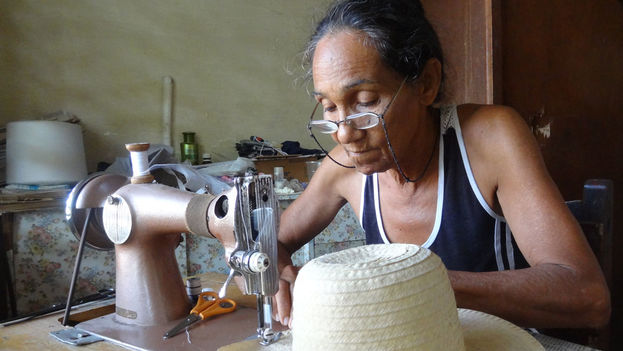
 14ymedio, Sol Garcia Basulto, Camagüey, 6 August 2016 – The fiber rubs the fingertips and leaves a pleasant burning, almost a caress. The life of Syria Noris Rodriguez revolves around the fronds of the yarey palm, with which she creates hats, bags and baskets. In the municipality of Rio Cauto, in the province of Granma, this petite woman with deft hands maintains a tradition languishing under the passage of time and fashions.
14ymedio, Sol Garcia Basulto, Camagüey, 6 August 2016 – The fiber rubs the fingertips and leaves a pleasant burning, almost a caress. The life of Syria Noris Rodriguez revolves around the fronds of the yarey palm, with which she creates hats, bags and baskets. In the municipality of Rio Cauto, in the province of Granma, this petite woman with deft hands maintains a tradition languishing under the passage of time and fashions.
Siria’s whole house has a peculiar aroma, where the scents of the Cuban countryside mix with the sweat that flows when facing the sewing machine. She spends hours there, stitch by stitch joining the dry palm fronds that will rest on a farmer’s head, in the hands of housewife heading to the market, or in the beautiful bassinet where a newborn sleeps.
Siria’s creations end up with ordinary Cubans, not on the shelves where tourists buy souvenirs of their trip. It was not her decision, but that of the bureaucracy. She didn’t have the prerequisites – an academic background as an artist and membership in the Cuban Association of Artisans and Artists (ACAA) – to place her works in the commercial areas of hotels, bazaars and boutiques.
Not being a member of ACAA limits the economic dividends Siria can get for her work. So after several decades of weaving the fiber, she doesn’t live much better than those who receive a salary for working eight hours a day for the state. If she takes a day off she has to sew more when she returns to her machine. There are days when she wakes up dreaming that someone will knock on the door and take a mountain of hats, to be able to put something on the dinner table.
In the family workshop, everyone helps out. There are sisters, grandchildren and neighbors who work with the drying, taking care “not to spoil it,” says Siria. After the leaves open “you have to make the yarey fine” and only then can you make the braid, like a belt, with which all kinds of objects can be woven.
“A hat for an adult has a braid of 15 or 16 rounds, and that’s a full day’s work,” says the artisan, without taking her eyes off the long fiber she is feeding under the needle.
She and her siblings learned to work with the yarey from their mother, Petronila Mendoza, who learned it in turn from her mother and she from hers. “We have worked for generations,” says Siria, who shares the workshop with her older sister while acknowledging that “everyone who comes by the house helps out.”
The palm fronds must be bought from farm workers, some of whom exchange them for hats or baskets for later use in the fields.
Sometimes there are some bad fronds, but this woman’s sharp eye sees them at once. “The weather affects it, the best hours for weaving are in the morning and at night, because the rest of the time the palm is too hard because there is less moisture in the air,” she explains.
A man’s hat can sell for a price that varies between 30 to 40 Cuban pesos, depending on size. “Anyone can buy this, of any profession, whether a farmer or a vendor,” she adds. She remains hopeful that the tradition of weaving yarey palm fronds will not die out because there are a lot of young people “interested in learning.”
Sometimes Siria gets up feeling pessimistic and thinks about leaving her work with this natural fiber. “It’s too hard,” she comments, but then immediately recognizes that her work is entertaining. “I start weaving and it clears the mind and I forget the pains.”
